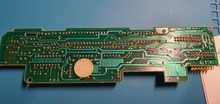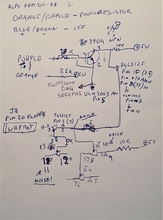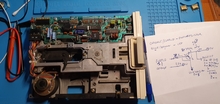Hi all, I posted this on the discord channel but Tom suggested to post it also here for reference so here it is (I added some pics for reference). I was having trouble with my IIc floppy, more specifically when writings as reading was working fine (I hadn't used it in a while). When attempting to save anything I would get random write protect or IO Error. Sometimes it would hint on starting to save (creating the file name for ex.) but shortly after give IO Error or simply a Write protect. So it was time to investigate. I have a Floppy Emu (BMOW) so I tested the floppy port to be sure everything on the IIc side was ok which I suspected it was, and in fact saving to the Emu worked fine. So I disassembled the ALPS drive and started doing some some investigation starting from the Write Protect LED/Photoresistor signals. I looked for an online schematic of this drive but could not find any. I did some REI on the signals starting from the diode/photresistor couple which lead me to the 2N3904 transistor and 74LS125 Quad buffer w/latch. First I checked that the photo resistor was actually working by checking the resistance variation by shining an LED torch which worked fine (resistance dropped to under 4K from megaohms). Then while powering the drive I checked the transistor Collector level (the photo resistor was driving the base) which dropped from +5 to around .6V which also indicated a good junction. Then I followed up and checked the 74LS125 Quad Buffer input and output (pins 3 as out, 2 input and 1 is the latch/enable when LOW) and this also switched from +5V to .6V when moving the floppy notch in and out - all good. Then I checked the WRPOTECT line with a scope and lo and behold when just reading from the drive, as soon as it would spin up I would see a ton of noise instead of a clean +5V or 0V flat line. That's why I was getting IO Errors and write protect errors from the Apple as it would have an inconsistent state while attempting to WRITE. So what was causing this incredible noise? The input was clean but the output was a bunch of oscillating noise - all the rest of the signals into the Quad Buffer were clean. So I decided to remove the 74LS125 and the transistor just to be sure - I tested the transistor and it turned out fine. I soldered on a socket and replaced the 74LS125A and while I was at it I refreshed some soldering joints. That's it I tested it and it works fine now, WPRotect signal is clean as it should be. Maybe it was not the LS125, could have been some cold soldering joint - who knows. I tested the 74LS125 on my TL866II and it turned out fine, but it could very well be borderline as these logic tests put very little drain current (uAmps) on the outputs. In any case, the ALPS drive works fine now, cleaned the heads with ISO Prop alcohol and seems good as new!
Here are some pics, forgive the rough REI circuit diag, I just did the Open/Close notch detect part concerning the issue (no point bothering with the amplifier section). Unfortunately I didn't take any scope shots of when it was having the issue, just imagine a whole lot of noise triggering from 0 to +5V at very high frequency (several hundred KHz at least). It's very simple and easy to follow as all these designs of the 80s where everything can be repaired with a basic scope and good multimeter. The whole repair from disassembly to testing took less than 90 minutes and was fun!






I found the schematic of the IIc floppy in Sams_Computer_Facts_Apple_IIc PDF file available from The Internet Archive - it's got all the needed info:
https://archive.org/details/Sams_Computer_Facts_Apple_IIc
Oh well, had fun all the same reparing it without it (luckily it wasn't a too puzzling fault)!
Looks like it was a cold solder joint on the LS125. It may have been visible by inspection prior to your removing it.
I did check the solder joints in general on the LS125 and the transistor - I redid a few including the ones on the transistor when I removed and reinserted it but that didn't help. It may have been a cold solder on one of the resistors which fed the +5V pullup I believe to one of the LS125 inputs though, which I redid when I socketed it. I might try putting back the original LS125 and see what happens!
FYI I put the original 74LS125AN back in and the drive failed to write again - so yes it is definitely defective even if it passes the logic IC test! Shows you how much logic IC testers aren't infallable.
It's still possible that the ZIF socket of the IC tester makes contact to a different part of the pin surface than the socket in the drive.
But I agree that proper testing of ICs is not so simple.